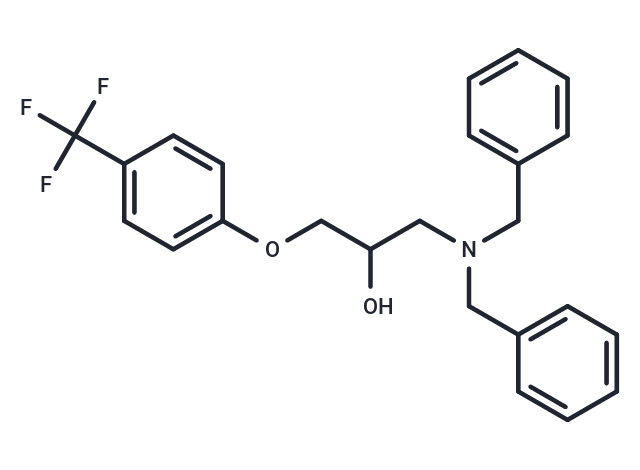Shopping Cart
- Remove All
 Your shopping cart is currently empty
Your shopping cart is currently empty

BC1618 (2-Propanol, 1-[bis(phenylmethyl)amino]-3-[4-(trifluoromethyl)phenoxy]-) is an orally active Fbxo48 inhibitor that stimulates Ampk-dependent signaling. It promotes mitochondrial fission, promotes autophagy and improves hepatic insulin sensitivity.

| Pack Size | Price | Availability | Quantity |
|---|---|---|---|
| 1 mg | $30 | In Stock | |
| 5 mg | $76 | In Stock | |
| 10 mg | $122 | In Stock | |
| 25 mg | $247 | In Stock | |
| 50 mg | $422 | In Stock | |
| 100 mg | $628 | In Stock | |
| 1 mL x 10 mM (in DMSO) | $84 | In Stock |
| Description | BC1618 (2-Propanol, 1-[bis(phenylmethyl)amino]-3-[4-(trifluoromethyl)phenoxy]-) is an orally active Fbxo48 inhibitor that stimulates Ampk-dependent signaling. It promotes mitochondrial fission, promotes autophagy and improves hepatic insulin sensitivity. |
| In vivo | BC1618, whose potency in stimulating Ampk-dependent signaling greatly exceeds 5-aminoimidazole-4-carboxamide-1-β-ribofuranoside (AICAR) or metformin.?This compound increases the biological activity of Ampk not by stimulating the activation of Ampk, but rather by preventing activated pAmpkα from Fbxo48-mediated degradation.?Consistenting with augmenting Ampk activity, BC1618 promotes mitochondrial fission, facilitates autophagy and improves hepatic insulin sensitivity in high-fat-diet-induced obese mice[1]. |
| Alias | 2-Propanol, 1-[bis(phenylmethyl)amino]-3-[4-(trifluoromethyl)phenoxy]- |
| Molecular Weight | 415.45 |
| Formula | C24H24F3NO2 |
| Cas No. | 2222094-18-8 |
| Smiles | OC(COc1ccc(cc1)C(F)(F)F)CN(Cc1ccccc1)Cc1ccccc1 |
| Relative Density. | 1.223 g/cm3 (Predicted) |
| Storage | Powder: -20°C for 3 years | In solvent: -80°C for 1 year | Shipping with blue ice. | |||||||||||||||||||||||||||||||||||
| Solubility Information | DMSO: 100 mg/mL (240.70 mM), Sonication is recommended. | |||||||||||||||||||||||||||||||||||
Solution Preparation Table | ||||||||||||||||||||||||||||||||||||
DMSO
| ||||||||||||||||||||||||||||||||||||

Copyright © 2015-2024 TargetMol Chemicals Inc. All Rights Reserved.